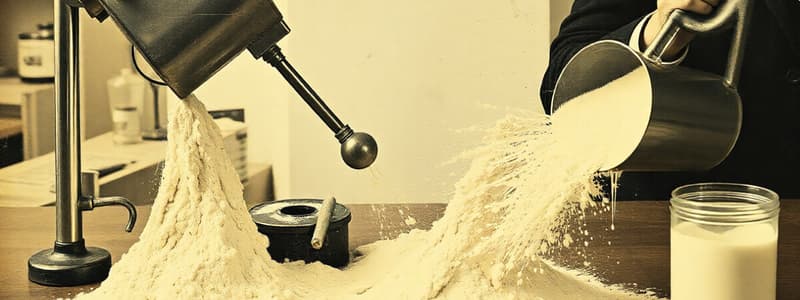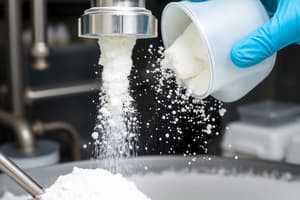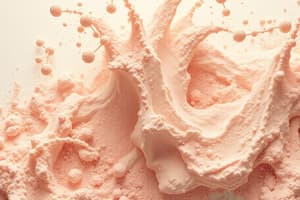Podcast
Questions and Answers
What is the role of the gas stream in fluidised bed mixers?
What is the role of the gas stream in fluidised bed mixers?
- To create turbulence and increase particle mobility (correct)
- To minimize energy consumption
- To increase the weight of the particles
- To enhance particle segregation
What is the optimal loading ratio for fluidised bed mixers with respect to vessel volume?
What is the optimal loading ratio for fluidised bed mixers with respect to vessel volume?
- 50-80%
- 25-35%
- 20-30% (correct)
- 80-90%
Which of the following is NOT a safety consideration in the choice of a mixer?
Which of the following is NOT a safety consideration in the choice of a mixer?
- Energy consumption
- Mixing time
- Mixer speed
- Color of the mixer (correct)
What mixing mechanism ensures adequate mix during further handling and processing?
What mixing mechanism ensures adequate mix during further handling and processing?
What issue can arise from large differences in particle size, shape, and density during mixing?
What issue can arise from large differences in particle size, shape, and density during mixing?
What is the primary goal of powder mixing?
What is the primary goal of powder mixing?
Which of the following mixing types involves the addition of a liquid binder?
Which of the following mixing types involves the addition of a liquid binder?
What does the process of post-mixing typically involve?
What does the process of post-mixing typically involve?
Which of the following is NOT a component of a powder mix?
Which of the following is NOT a component of a powder mix?
How does mixing impact the mechanical properties of a tablet?
How does mixing impact the mechanical properties of a tablet?
What is a significant disadvantage of Y-cone and cylinder mixers?
What is a significant disadvantage of Y-cone and cylinder mixers?
What is one of the main advantages of using a convective mixer for powder mixing?
What is one of the main advantages of using a convective mixer for powder mixing?
Which feature is an advantage of using Y-cone and cylinder mixers?
Which feature is an advantage of using Y-cone and cylinder mixers?
What is a major disadvantage mentioned regarding convective mixers?
What is a major disadvantage mentioned regarding convective mixers?
What characteristic defines impaction and high shear mixers?
What characteristic defines impaction and high shear mixers?
Which mixer type is described as having blades rotating at high speeds within a static vessel?
Which mixer type is described as having blades rotating at high speeds within a static vessel?
Which mixer type is noted for rarely being used for dry powder mixing?
Which mixer type is noted for rarely being used for dry powder mixing?
What disadvantage is associated with high shear mixers?
What disadvantage is associated with high shear mixers?
What is the mechanism called that involves the random movement of individual particles in a powder system?
What is the mechanism called that involves the random movement of individual particles in a powder system?
Which mixing mechanism is typically associated with the transfer of groups of particles?
Which mixing mechanism is typically associated with the transfer of groups of particles?
In which type of mixer are all three mixing mechanisms effectively incorporated?
In which type of mixer are all three mixing mechanisms effectively incorporated?
How does particle size impact drug distribution during mixing?
How does particle size impact drug distribution during mixing?
Which of the following factors does NOT affect segregation in powder mixing?
Which of the following factors does NOT affect segregation in powder mixing?
What is a method suggested to mitigate segregation when mixing powders?
What is a method suggested to mitigate segregation when mixing powders?
What probability signifies the chance of picking two particles of the same type in a perfect mixture of 100 particles (50:50)?
What probability signifies the chance of picking two particles of the same type in a perfect mixture of 100 particles (50:50)?
To achieve a perfect mix, how are particles ideally arranged?
To achieve a perfect mix, how are particles ideally arranged?
What technique can improve drug content uniformity during testing?
What technique can improve drug content uniformity during testing?
What is the effect of shear in particle mixing?
What is the effect of shear in particle mixing?
What is the purpose of pre-mixing in powder mixing?
What is the purpose of pre-mixing in powder mixing?
Which type of mixing is characterized by the absence of a liquid phase?
Which type of mixing is characterized by the absence of a liquid phase?
How can mixing affect the bioavailability of a drug?
How can mixing affect the bioavailability of a drug?
Which of the following best describes the role of a lubricant in post-mixing?
Which of the following best describes the role of a lubricant in post-mixing?
What is a critical factor in achieving homogeneous mixing of the components?
What is a critical factor in achieving homogeneous mixing of the components?
What is one of the primary considerations regarding the loading ratio for fluidised bed mixers in terms of volume?
What is one of the primary considerations regarding the loading ratio for fluidised bed mixers in terms of volume?
Which factor is NOT associated with increasing the risk of explosion in powder mixing operations?
Which factor is NOT associated with increasing the risk of explosion in powder mixing operations?
What mechanical behavior is crucial during the mixing process to avoid segregation?
What mechanical behavior is crucial during the mixing process to avoid segregation?
Which aspect is critical to consider when selecting a mixer based on economical and safety considerations?
Which aspect is critical to consider when selecting a mixer based on economical and safety considerations?
Which of the following statements is true regarding the expansion of the powder bed in mixing?
Which of the following statements is true regarding the expansion of the powder bed in mixing?
What is a significant advantage of using Y-cone and cylinder mixers?
What is a significant advantage of using Y-cone and cylinder mixers?
What is a common disadvantage associated with convective mixers?
What is a common disadvantage associated with convective mixers?
Which of the following best describes an impact mixer?
Which of the following best describes an impact mixer?
What is a key characteristic of high shear mixers?
What is a key characteristic of high shear mixers?
What specific disadvantage may occur when using high shear mixers?
What specific disadvantage may occur when using high shear mixers?
What is the primary function of the impeller in convective mixers?
What is the primary function of the impeller in convective mixers?
Which type of mixer is most likely to experience problems with particle segregation?
Which type of mixer is most likely to experience problems with particle segregation?
What is a notable drawback of using impact mixers at high speeds?
What is a notable drawback of using impact mixers at high speeds?
Which mixing mechanism primarily involves the organized transfer of groups of particles?
Which mixing mechanism primarily involves the organized transfer of groups of particles?
What leads to poor drug distribution during mixing with large drug particles?
What leads to poor drug distribution during mixing with large drug particles?
Which factor does NOT directly affect the segregation of powders during mixing?
Which factor does NOT directly affect the segregation of powders during mixing?
In order to achieve a satisfactory mix when segregation is a concern, which method is recommended?
In order to achieve a satisfactory mix when segregation is a concern, which method is recommended?
What is the probability of finding two white particles when sampling from a random mixture of 100 particles consisting of 50 blue and 50 white particles?
What is the probability of finding two white particles when sampling from a random mixture of 100 particles consisting of 50 blue and 50 white particles?
Which of the following is characteristic of a perfect mix?
Which of the following is characteristic of a perfect mix?
When mixing powders, what contributes to the effectiveness of a mixer with all three mechanisms incorporated?
When mixing powders, what contributes to the effectiveness of a mixer with all three mechanisms incorporated?
What is typically observed in a random mixture when sampling particles?
What is typically observed in a random mixture when sampling particles?
For cohesive, fine powders often used in direct compression, what type of mixture is typically expected?
For cohesive, fine powders often used in direct compression, what type of mixture is typically expected?
What causes poor distribution of particles when mixing, according to particle behavior principles?
What causes poor distribution of particles when mixing, according to particle behavior principles?
Flashcards
Powder Mixing
Powder Mixing
The process of combining two or more powder components to achieve a homogeneous distribution of each component in the powder bulk. This means each particle of one component is as close as possible to particles of all other components.
Dry Mixing
Dry Mixing
A type of powder mixing where a liquid is not added. Powders are combined directly.
Wet Mixing
Wet Mixing
A type of powder mixing that involves adding a liquid binder to the powders to form granules. This improves flowability and compaction.
Pre-mixing
Pre-mixing
Signup and view all the flashcards
Post-mixing
Post-mixing
Signup and view all the flashcards
Y-cone Mixer
Y-cone Mixer
Signup and view all the flashcards
Convective Mixer
Convective Mixer
Signup and view all the flashcards
High Shear Mixer
High Shear Mixer
Signup and view all the flashcards
Planetary Mixer
Planetary Mixer
Signup and view all the flashcards
Impaction Mixer
Impaction Mixer
Signup and view all the flashcards
Nautamixer
Nautamixer
Signup and view all the flashcards
Cube, Cone, and V Mixers
Cube, Cone, and V Mixers
Signup and view all the flashcards
Turbula Mixer
Turbula Mixer
Signup and view all the flashcards
Fluidized Bed Mixing
Fluidized Bed Mixing
Signup and view all the flashcards
Optimal Loading Ratio
Optimal Loading Ratio
Signup and view all the flashcards
Particle Attrition
Particle Attrition
Signup and view all the flashcards
Powder Segregation
Powder Segregation
Signup and view all the flashcards
Temperature Change During Mixing
Temperature Change During Mixing
Signup and view all the flashcards
Diffusion in powder mixing
Diffusion in powder mixing
Signup and view all the flashcards
Convection in powder mixing
Convection in powder mixing
Signup and view all the flashcards
Shear in powder mixing
Shear in powder mixing
Signup and view all the flashcards
Tumbling mixers
Tumbling mixers
Signup and view all the flashcards
Low shear blade/paddle mixers
Low shear blade/paddle mixers
Signup and view all the flashcards
Interactive powder mixture
Interactive powder mixture
Signup and view all the flashcards
Random powder mixture
Random powder mixture
Signup and view all the flashcards
Segregation in powders
Segregation in powders
Signup and view all the flashcards
Diffusion (Powder Mixing)
Diffusion (Powder Mixing)
Signup and view all the flashcards
Convection (Powder Mixing)
Convection (Powder Mixing)
Signup and view all the flashcards
Shear (Powder Mixing)
Shear (Powder Mixing)
Signup and view all the flashcards
Segregation (Powder Mixing)
Segregation (Powder Mixing)
Signup and view all the flashcards
Perfect Mixture (Powder)
Perfect Mixture (Powder)
Signup and view all the flashcards
Random Mixture (Powder)
Random Mixture (Powder)
Signup and view all the flashcards
Study Notes
MPharm Programme - Powder Mixing
- Powder mixing involves treating two or more powder components to place each particle of one component in contact with each particle of the other components.
- The aim of powder mixing is to achieve a homogeneous distribution of components within the powder bulk.
- Components of a powder mix include different types of powders (drugs and excipients) and varying particle size fractions of the same powder.
- Powder mixing is essential in various pharmaceutical processes, including granulation, tabletting, direct compression, capsule and sachet filling, and vial filling for injections.
Mixing and Solid Dosage Forms
- Drugs and excipients possess different physicochemical properties.
- Mixing affects the homogeneity of drug distribution in the dosage form, mechanical properties (e.g., of a tablet), and the bioavailability of the drug.
Mixing Terminology
- Dry mixing: Mixing powders without adding a liquid phase.
- Wet mixing: Powder mixing with a liquid binder (e.g., granulation).
- Pre-mixing: Used for mixtures with less than 5% weight-by-weight (w/w) drug; further deagglomeration (e.g., sieving) is then performed.
- Post-mixing: The addition of an external phase like a lubricant or glidant. It typically has shorter mixing times (3-5 minutes).
Mixer Types
- Tumbler mixers: Used for free-flowing powders. Rotating vessels cause particles to tumble, allowing them to mix on the surface of the mixture. While effective, they can be prone to particle segregation. Impellers/prongs within the vessel can reduce this segregation. Advantages include no particle attrition and suitability for adding lubricants and glidants.
- Cube, cone, and V mixers: Rotating mixing vessels with different shapes (cone and V-shaped). These mixers are used for effective mixing.
- Turbula mixer: A specific type of mixer that appears as a box-like structure.
- Double cone mixer: A type of mixer utilizing a double conical shape.
- Convective mixers: Fixed mixing vessels that employ impellers to move particles from one part of the vessel to another. Some disadvantages include dead spaces where powder isn't effectively moved, adhesion to blades. High shear forces at the impeller surfaces can shatter powder particles. Hence, not recommended for dry powder mixing.
- Planetary mixers: A type of mixer featuring an apparatus with a rotating impeller that exerts rotation on the contents of the vessel.
- Nautamixer: A special mixer featuring a helical conveyor inside a conical vessel.
- Impaction and high shear mixers: These mixers significantly increase the energy input into the mix. Impaction mixers use blades rotating at high speeds (2000-3000 rpm) in a fixed vessel. High shear mixers subject the powder to intense shearing forces after convective/tumbling mixing (e.g., with rotating impellers and centrifugal forces). These mixers are frequently used to break up aggregates in the powder mixtures.
- Fluidized bed mixers: This type of mixer involves subjecting the powder to a flowing gas stream, countering the particles' weight with their buoyancy to increase particle mobility and create turbulence. They are often viewed as highly efficient and fast.
Choice of Mixer: Considerations
- Physical considerations: The choice of mixer depends on the space required by the optimal loading ratio and potential for particle attrition or overmixing during the process. Different mixers have different optimal loading ratios, ranging from 25-35% for tumbling mixers to 20-30% for fluidized bed mixers; temperature changes also need consideration.
- Economic and safety considerations: Considerations include energy consumption, mixing time, continuous versus batch approach, time for filling, emptying, and cleaning the mixers, dust emission, and explosion hazard related to electrostatic charging of surfaces and mixer speeds. The environment's relative humidity may also be important.
Mixing Mechanisms
- Expansion and agitation: These processes allow particles to move in the powder bed and mix adequately. Maintenance of a quality mix throughout handling and treatment of the powders is critical. Mixing often involves minimizing particle size, shape, and density differences.
- Diffusion: Random movement of individual particles; often referred to as micromixing.
- Convection: Movement of groups of particles; often termed macromixing.
- Shear: Particles sliding past each other along slip planes.
- Types of powder mixers and their predominant types of mixing.
Interactive Powder Mixtures ('Ordered Mixtures')
- Often involve cohesive, fine powders with coarse powders (e.g., coater/carrier units).
- Interparticulate forces contribute to stability.
Ordered and Random Mixes
- Perfect mix: Each particle is adjacent to a particle of the other component.
- Random mix: A maximum degree of disorder makes it impossible to predict a particle's type from its neighbours in the mixture.
Factors Affecting Segregation
- Particle size, density, shape, electrostatic charging, powder handling, the choice of equipment is vital to consider when encountering problems related to segregation.
Testing for Drug Content Uniformity
- Assessing drug content uniformity requires random sampling and analysis, followed by inspection using standard deviation and coefficient of variation. This should be compared against pharmacopoeial standards.
Effects of Particle Size on Drug Distribution During Mixing
- Large particles lead to poor distribution, while smaller particles are more easily dispersed. Particle agglomeration also results in poor drug distribution, while smaller, uniform particle sizes benefit from good dispersion.
Studying That Suits You
Use AI to generate personalized quizzes and flashcards to suit your learning preferences.




